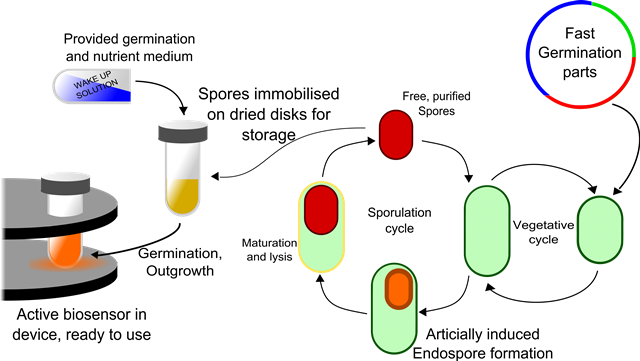Team:Cambridge/Project/Sporulation and Germination
From 2012.igem.org
(→Sporage and Distribution) |
(→Sporage and Distribution) |
||
| Line 4: | Line 4: | ||
=<span style="color:#585858">Sporage and Distribution</span>= | =<span style="color:#585858">Sporage and Distribution</span>= | ||
<span style="color:#585858"> | <span style="color:#585858"> | ||
| - | An issue with existing biosensors is the longevity of the product. E.coli has been a popular biosensor chassis to date, however cultures require regular maintenance, or cumbersome and energy intensive freezing processes. Long term distribution and hassle-free storage requires a more robust chassis. | + | An issue with existing biosensors is the longevity of the product. E.coli has been a popular biosensor chassis to date, however cultures require regular maintenance, or cumbersome and energy intensive freezing processes. Long term distribution and hassle-free storage requires a more robust chassis. Tubes of the sporduino bacterial 'sensors' can sit in the user's cupboard, with a generous shelf life, until needed. When the user requires a specific sensor, the appropriate strain is selected and the bacteria can be germinated by following a simple protocol. The tube can then be placed into the arduino device, the test sample loaded and the concentration profile measured. |
| - | + | ||
| - | Tubes of the sporduino bacterial 'sensors' can sit in the user's cupboard, with a generous shelf life, until needed. When the user requires a specific sensor, the appropriate strain is selected and the bacteria can be germinated by following a simple protocol. The tube can then be placed into the arduino device, the test sample loaded and the concentration profile measured. | + | |
Part of the main reason for choosing ''Bacillus subtilis'' as our chassis was because of it's abiltiy to form dormant spores. ''Sporage and Distribution'' aims to determine a procedure for inducing sporulation in ''Bacillus'', and developing a very simple, user friendly and field worthy protocol for germinating the spores. | Part of the main reason for choosing ''Bacillus subtilis'' as our chassis was because of it's abiltiy to form dormant spores. ''Sporage and Distribution'' aims to determine a procedure for inducing sporulation in ''Bacillus'', and developing a very simple, user friendly and field worthy protocol for germinating the spores. | ||
Revision as of 16:10, 25 September 2012


Sporage and Distribution
An issue with existing biosensors is the longevity of the product. E.coli has been a popular biosensor chassis to date, however cultures require regular maintenance, or cumbersome and energy intensive freezing processes. Long term distribution and hassle-free storage requires a more robust chassis. Tubes of the sporduino bacterial 'sensors' can sit in the user's cupboard, with a generous shelf life, until needed. When the user requires a specific sensor, the appropriate strain is selected and the bacteria can be germinated by following a simple protocol. The tube can then be placed into the arduino device, the test sample loaded and the concentration profile measured.
Part of the main reason for choosing Bacillus subtilis as our chassis was because of it's abiltiy to form dormant spores. Sporage and Distribution aims to determine a procedure for inducing sporulation in Bacillus, and developing a very simple, user friendly and field worthy protocol for germinating the spores.
It is essential for the germination procedure to be as straight forward as possible, requiring minimal equipment and expertise, so that it could in theory be performed in the field, in a situation where the biosensor might be used.
Germination is a time consuming event. The sooner germination and outgrowth is completed, the quicker the biosensing capability of the system can be implemented, which is the primary goal. There are several synthetic biology approaches to speeding up germination. One operon we investigated is the spoVA operon. Upon over expression
References
 "
"
